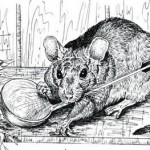 Recently, one young Irish mother was buckling her toddler into his car seat when she noticed rat droppings all over the back seat and noticed gnaw-marks on the back seats and head rests. Her car was infested with rats! Of course, she immediately took her child out of the car, locked it, and called a friend for help. She and her friend have tried to lure the rats out and poison them, but so far, they’re still a problem.
Recently, one young Irish mother was buckling her toddler into his car seat when she noticed rat droppings all over the back seat and noticed gnaw-marks on the back seats and head rests. Her car was infested with rats! Of course, she immediately took her child out of the car, locked it, and called a friend for help. She and her friend have tried to lure the rats out and poison them, but so far, they’re still a problem.
Anyone with little ones knows the car that the kids ride in the most is covered in toys, shed jackets, a few crayons or markers, and lots and lots of dropped food. It’s a mecca for rats, mice or anything that can get inside. There’s plenty to eat and lots of things to gnaw on.
This woman already had a phobia of rats, and now she’s terrified she’ll be driving down the road just to have one scamper over her foot. I would be equally afraid that a rat would gnaw through a crucial wire or hose.
Ireland isn’t alone in its rat problems. Plenty of U.S. cities are struggling right now to eradicate their rats. New York City and Baltimore, for example, are making a concerted effort to take care of their rat infestations. But, smaller, more rural towns which are overrun with the rodents may not have the resources yet to fully manage the problem.
Additionally, there is a great deal of controversy over cities laying out rat poison, which may cause secondary poisoning. Secondary poisoning is when a rat has consumed rat poison and is then, in turn, consumed by a predator such as a cat, hawk, coyote or snake. Recently, two bobcats were found dead on the East coast, after consuming rats who had not died yet from poisoning. Bird lovers are dismayed by the deaths of hawks who had eaten poisoned rats.
But, a rat infestation is a serious danger. We were already aware of numerous diseases that can be transmitted to humans from rats, but a recent study of New York City rats just revealed 18 additional previously unknown diseases harbored by the rodents. That doesn’t even begin to address the structural or electrical damage rats can cause to buildings, and apparently also cars.
So, where do we draw the line between guarding against secondary poisoning to other animals and guarding the health and safety of human beings?